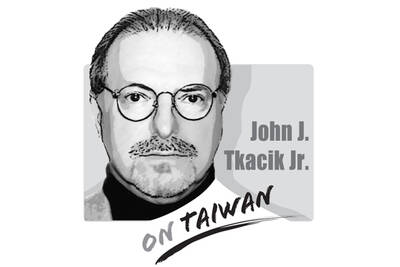Ukrainians have been putting up fierce resistance to Russia’s invasion, demonstrating their valor and dignity to the world.
With NATO and the US holding back their troops, Russian President Vladimir Putin had thought he could quickly seize Ukraine by means of superior military force.
Reports of the bravery of Ukrainian soldiers holding off an attack on Snake Island, also known as Zmiinyi Island, bolstered their resolve to defend their country, thereby creating new challenges for Russian troops.
Aside from their united resolve, Ukrainians’ ability to repel Russia’s invasion has much to do with their extensive weapons training. Consequently, when the Ukrainian government distributed guns to those who were willing to take up arms against Russia, citizens immediately formed a unit of force.
As China has never been shy of showing its expansionist tendency, there might come a time when Taiwan has no choice but to enter into war. Rather than be caught unaware, Taiwan should prepare.
As military conscription and length of service cannot be reformed at short notice, and as arms procurement and developing one’s own artillery takes time, Taiwan’s priority should be training reserve soldiers and cultivating citizens’ immediate combat capabilities.
In simple terms, Taiwan should focus on training citizens at regular intervals to use modern weapons. The goal should be for citizens to know how to fire different weapons and how to deter an enemy. This policy should be implemented immediately.
The Ukrainian government has no qualms about distributing guns to its citizens because they possess the knowledge and skills to use them.
However, because of strict arms control laws, most Taiwanese have not even seen a gun, let alone handled one.
If the government does not train its citizens how to use modern weapons, there would not be much sense in handing weapons to those who are willing to take up arms for their country.
Teaching citizens how to use modern weapons is a most important step in Taiwan’s preparation for war.
Lai Hsin-yang is an adjunct assistant professor in the Department of Chinese Literature at National Taipei University.
Translated by Rita Wang
Chinese agents often target Taiwanese officials who are motivated by financial gain rather than ideology, while people who are found guilty of spying face lenient punishments in Taiwan, a researcher said on Tuesday. While the law says that foreign agents can be sentenced to death, people who are convicted of spying for Beijing often serve less than nine months in prison because Taiwan does not formally recognize China as a foreign nation, Institute for National Defense and Security Research fellow Su Tzu-yun (蘇紫雲) said. Many officials and military personnel sell information to China believing it to be of little value, unaware that
Before 1945, the most widely spoken language in Taiwan was Tai-gi (also known as Taiwanese, Taiwanese Hokkien or Hoklo). However, due to almost a century of language repression policies, many Taiwanese believe that Tai-gi is at risk of disappearing. To understand this crisis, I interviewed academics and activists about Taiwan’s history of language repression, the major challenges of revitalizing Tai-gi and their policy recommendations. Although Taiwanese were pressured to speak Japanese when Taiwan became a Japanese colony in 1895, most managed to keep their heritage languages alive in their homes. However, starting in 1949, when the Chinese Nationalist Party (KMT) enacted martial law

“Si ambulat loquitur tetrissitatque sicut anas, anas est” is, in customary international law, the three-part test of anatine ambulation, articulation and tetrissitation. And it is essential to Taiwan’s existence. Apocryphally, it can be traced as far back as Suetonius (蘇埃托尼烏斯) in late first-century Rome. Alas, Suetonius was only talking about ducks (anas). But this self-evident principle was codified as a four-part test at the Montevideo Convention in 1934, to which the United States is a party. Article One: “The state as a person of international law should possess the following qualifications: a) a permanent population; b) a defined territory; c) government;
The central bank and the US Department of the Treasury on Friday issued a joint statement that both sides agreed to avoid currency manipulation and the use of exchange rates to gain a competitive advantage, and would only intervene in foreign-exchange markets to combat excess volatility and disorderly movements. The central bank also agreed to disclose its foreign-exchange intervention amounts quarterly rather than every six months, starting from next month. It emphasized that the joint statement is unrelated to tariff negotiations between Taipei and Washington, and that the US never requested the appreciation of the New Taiwan dollar during the